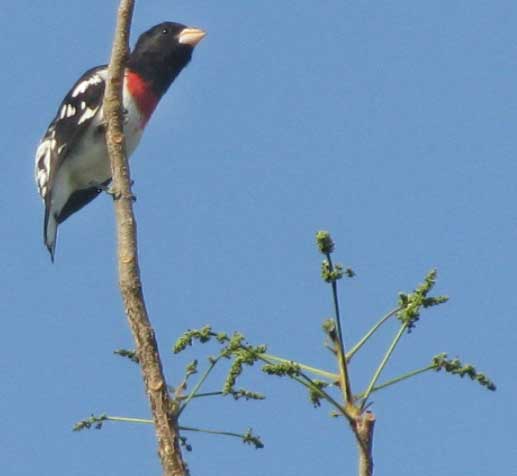Excerpts from Jim Conrad's
Naturalist Newsletter
from the April 17, 2011 Newsletter issued from Hacienda Chichen Resort beside Chichén Itzá Ruins, central Yucatán, MÉXICO
ROSE-BREASTED GROSBEAK HEADED NORTH
Below you see a Rose-breasted Grosbeak, PHEUCTICUS LUDOVICIANUS, in a Gumbo-Limbo.

Again we had a winter visitor migrating north, and again he looked a little strange in a flowering Gumbo-Limbo tree. In the US Southeast we see Rose-breasted Grosbeaks only during migration, so I associate the species with cool weather. However, the bird in the picture visited on a day when the temperature rose well over 100° (38°). What an amazing thing that these little birds not only fly across the Gulf of Mexico, but also survive the extreme weather changes they encounter on arrival.
I heard this bird's loud, sharp PEEK! call before I saw him. He seemed to be craning his neck, trying to find the source of the sound made by my water faucet as I filled a bucket.
issued on October 29, 2019 from near Tepakán, north-central Yucatán state; elevation ~9m (~30 ft), N21.053°, W89.052°; MÉXICO
JUVENILE ROSE-BREASTED GROSBEAK
For a month or so I've noticed migratory birds returning to the tropics after nesting north. Down here, with courtship and nesting so far off, they don't put on much of a show. Normally they keeping quiet, maintaining low profiles, and wear subdued plumages. Their jobs now are just to eat and stay alive until next spring their courtship hormones kick in again. This week I heard a familiar sharp-sounding PEEK!, and there above me four or five Rose-breasted Grosbeaks were perched in a dead treetop looking around as if seeing this area for the first time. The bird shown below is in his juvenile plumage, the first plumage a bird has after losing its downy covering, so to him this whole tropical environment must be mind-blowing.

During the northern summer the species nests in the northeastern US and central and southeastern Canada, then overwinter in the southern Mexican lowlands south to western Nicaragua.